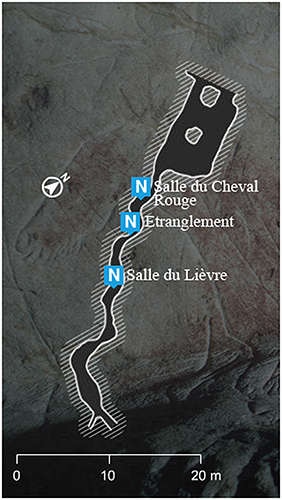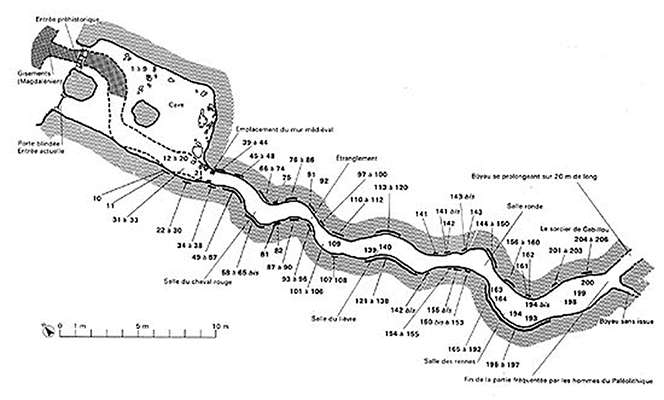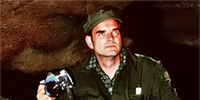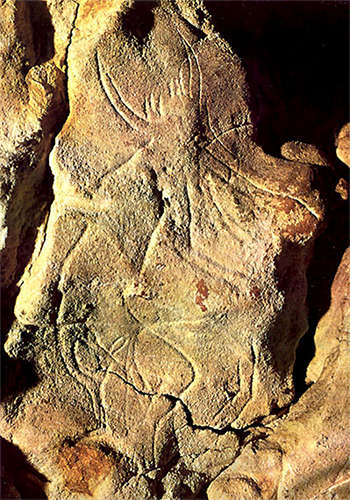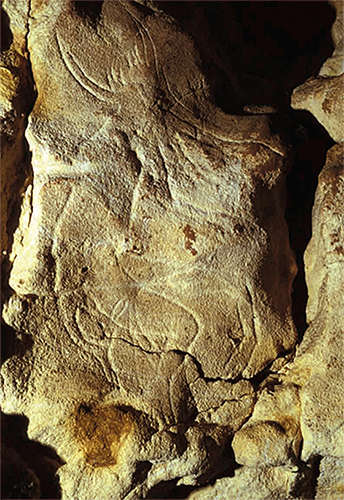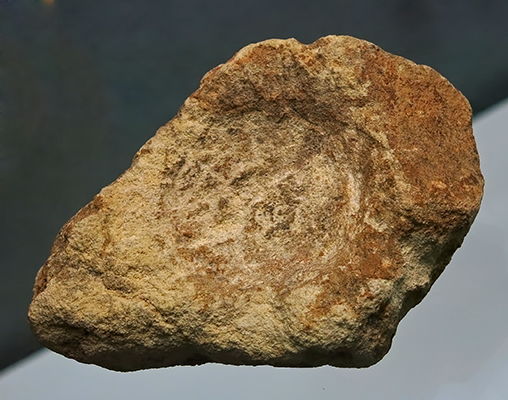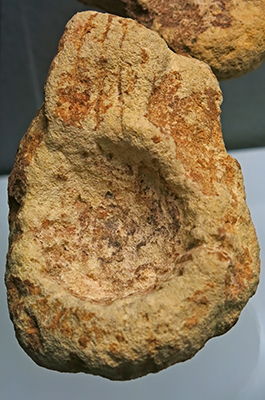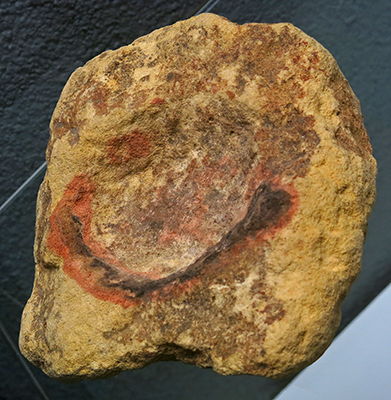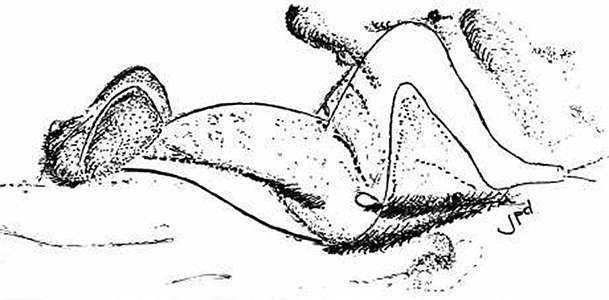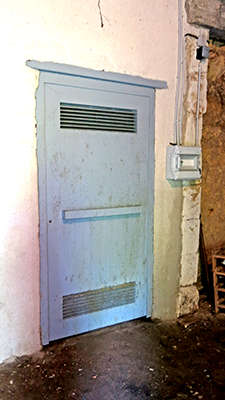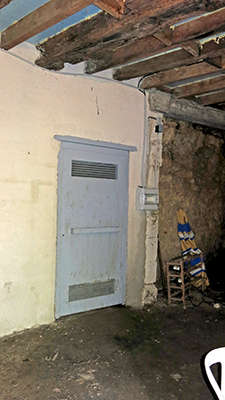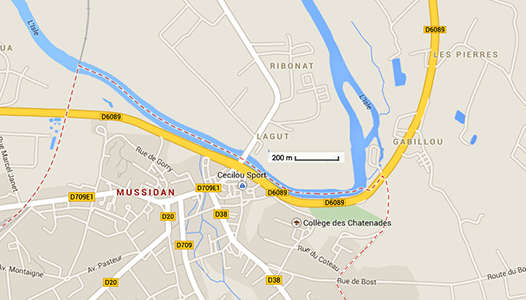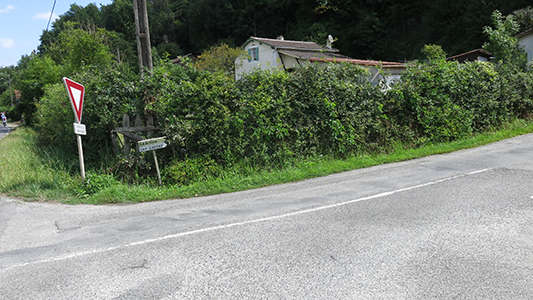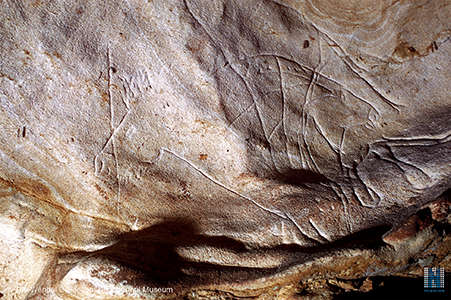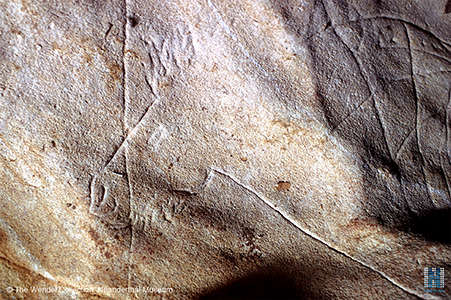Back to Don's Maps
Back to Sites Index Page
Grotte de Gabillou, Grotte de Las Agnelas
Text above translated and adapted from: David et al. 1952
Plan of the Grotte de Gabillou.
Photo (left): Heinrich Wendel (© The Wendel Collection, Neanderthal Museum)
Photo (right): http://www.europreart.net/cgi-bin/baserun.cgi?_cfg=record.cfg&_fil=code%3D%22gabil001%22

The Sorcerer, Grotte de Gabillou.
This is a horned and bearded figure, height ca 25 cm, length of panel including adjoining signs 27 cm.
Note that apart from the slimness of the torso, the only feature which defines this engraving as human is the way the back legs are bent, and the shape of the right leg and foot.
Photo (top left): http://www.zwoje-scrolls.com/zwoje38/text07ep.htm
Photo (top right): Clottes (2008)
Photo (left): http://www.delcampe.net/
Text: adapted from Guthrie (2006) and
Powers (1994)
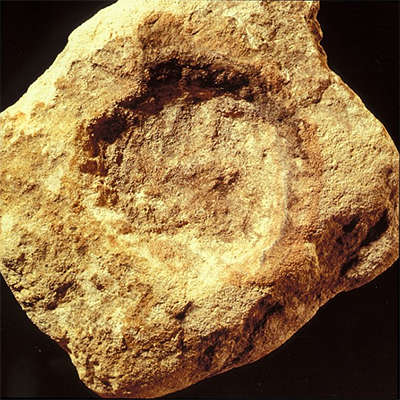
Lamp from Gabillou.
Photo: http://www.chaa.be/wp-content/uploads/2012/09/Pr%C3%A9histoire-Bestiaire-Slides.pdf
Lamp from Gabillou
Photo: Don Hitchcock 2015
Source: Original, Musée d'Aquitaine à Bordeaux
Lamps from Gabillou
Photo: Don Hitchcock 2015
Source: Original, Musée d'Aquitaine à Bordeaux
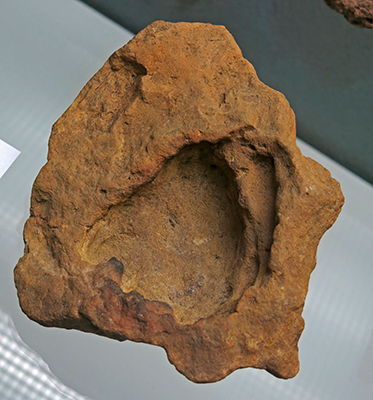
Although labelled in the museum as being from Grand Moulin, Lugasson, this is not the famous and well made lamp from there, and is instead from Gabillou. Note that Wikimedia Commons labels it as Lampe à graisse découverte à Mouthiers-sur-Boëme, which again is a mislabelling.
It turns out to be from Gabillou, as might be expected from its form and material, length 200 mm, width 170 mm, thickness 80 mm.
Catalog: 2000.13.4
Photo: Don Hitchcock 2015
Source: Original, Musée d'Aquitaine à Bordeaux

Lamp from Gabillou.
Photo: Don Hitchcock 2014
Source: Original, le Musée National de Préhistoire, Les Eyzies-de-Tayac

Spear points from Gabillou, some with longitudinal grooves.
Photo: Don Hitchcock 2014
Source: Original, le Musée National de Préhistoire, Les Eyzies-de-Tayac
Gabillou.
Woman in the posture of giving birth.
Photo: © jpd
Source: http://www.atramenta.net/lire/oeuvre23919-chapitre117486.html
The door to the Grotte de Gabillou is not visible from the street, it is beneath a house.
Only two or three visits a year are permitted, by prior appointment with the owners by people with appropriate qualifications and research interests.
Photo: Don Hitchcock 2014
Gabillou is a little village about one kilometre to the east of Mussidan, near the L'isle river.
Photo: Google maps.
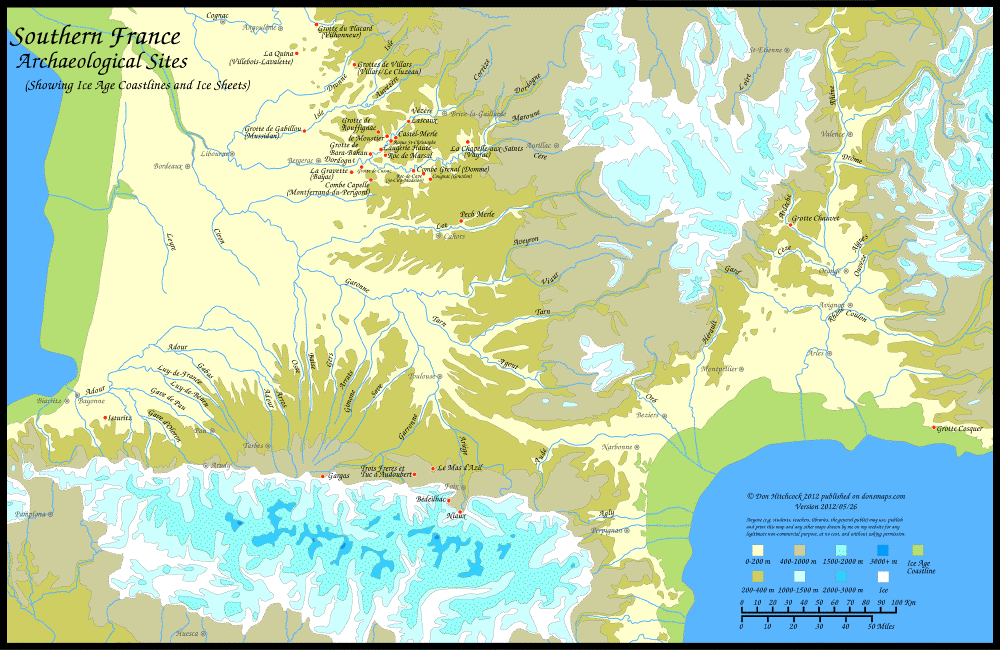
Note - Use this pdf file if you wish to print this map on a single sheet of paper.
Photo: Don Hitchcock version 2012/05/26
Near the site of the grotte, there is a restaurant (often called a Relais in this part of France), which is named after the village.
The noun Relais is derived from the old French relaier meaning a hotel that was used as a stop on long journeys, rather like the way that the English use the old word 'Inn' for a similar hotel situated beside a highway.
Photo: Don Hitchcock 2014
Salle du Cheval Rouge - Chamber of the Red Horse
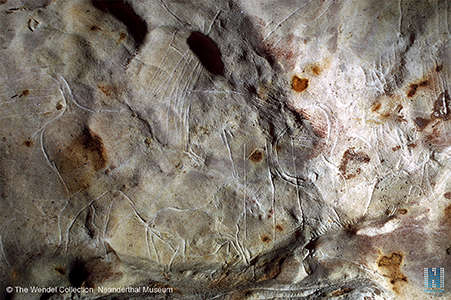
Engravings of a Bison and two Horses, one complete and one showing just the head and neck.
Photo: Heinrich Wendel (© The Wendel Collection, Neanderthal Museum)
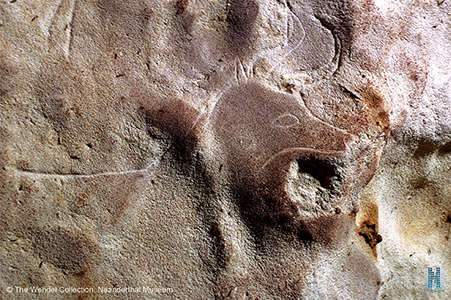
Engraving of the head of a deer.
Photo: Heinrich Wendel (© The Wendel Collection, Neanderthal Museum)
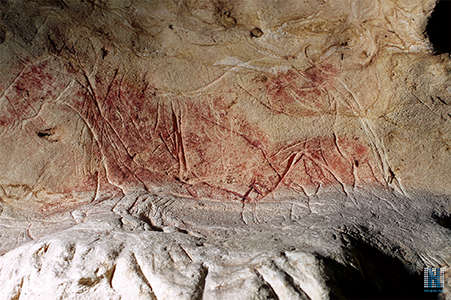
A very well executed engraving of a horse, infilled with red ochre. The artist has continued the legs of the horse on the horizontal part of the wall.
Photo: Heinrich Wendel (© The Wendel Collection, Neanderthal Museum)
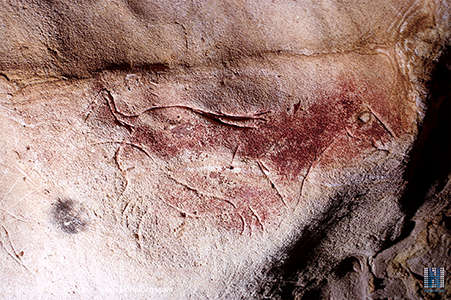
A superb galloping horse.
This horse has also been coloured with red ochre. The eye has been clearly shown, larger than life, but that may be a natural feature that the artist has taken advantage of to bring life to the depiction.
Photo: Heinrich Wendel (© The Wendel Collection, Neanderthal Museum)
Étranglement - The Constriction
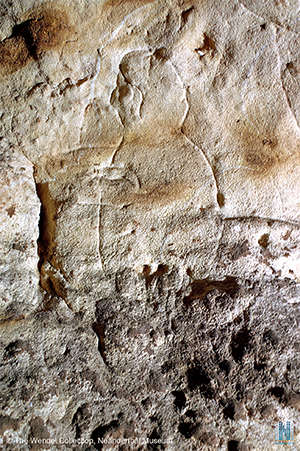
Engraving of a human figure.
This is one of the few examples of a clothed human in palaeolithic art. The figure has a parka type covering, and the artist has made good use of the bumps and natural features on the wall.
Photo: Heinrich Wendel (© The Wendel Collection, Neanderthal Museum)
Text: adapted from Guthrie (2006)
Engraving of a Horse and Ibex.
These figures are remarkable for the attention to detail of the muzzles, and the realistic depiction of the eyes.
Photo: Heinrich Wendel (© The Wendel Collection, Neanderthal Museum)

This engraving comes close to being a bas relief, especially at the forehead and jaw.
With just a few lines, the artist has brought the horse to life.
Photo: Heinrich Wendel (© The Wendel Collection, Neanderthal Museum)
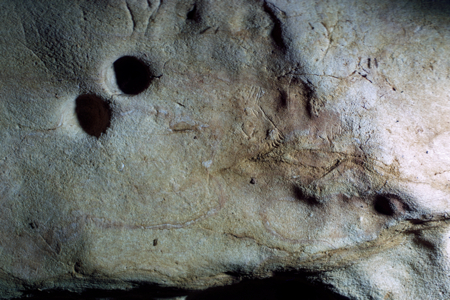
Horse head.
Photo: Heinrich Wendel (© The Wendel Collection, Neanderthal Museum)
Salle du Lièvre - Chamber of the Hare
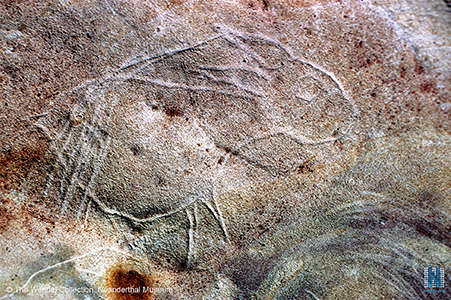
Engraving of a hare.
Photo: Heinrich Wendel (© The Wendel Collection, Neanderthal Museum)
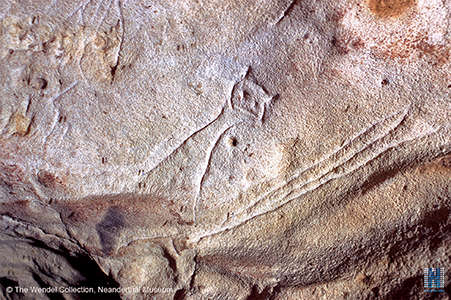
Engraving of a small carnivore, possibly a weasel or ermine, which would have been common in the area at the time.
Note the apparent repeated pattern or sign of two black elongated dots all over the surface - they are winged insects, and their shadow!
They may be seen on other images from this cave, and presumably are attracted by the lights used for modelling the engravings for the photographs.
Photo: Heinrich Wendel (© The Wendel Collection, Neanderthal Museum)
Text: adapted from Guthrie (2006)
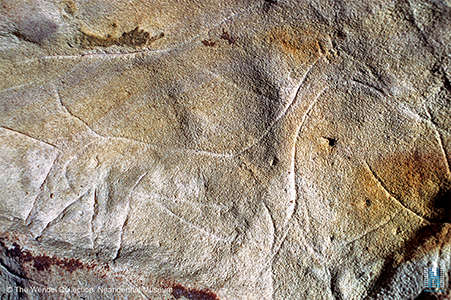
This whimsical creature looks more like a long necked dog than anything else.
Photo: Heinrich Wendel (© The Wendel Collection, Neanderthal Museum)
References
- Clottes, J., 2008, El Chamanismo Paleolítico: Fundamentos de una Hipótesis Veleia, , 24-25, 2007-2008
- David, J., Hervé M., Gauthier J., Malvesin-Fabre G., 1952, La grotte à gravures de Gabillou, Comptes rendus des séances de l'Académie des Inscriptions et Belles-Lettres, 96e année, N. 1, 1952. pp. 116-118.
- Guthrie, R., 2006, The Nature of Paleolithic Art, ISBN-13: 978-0226311265
- Powers, R., 1994, The Human Form in Palaeolithic Art, a special issue of Modern Geology, Vol 19, Parts 2-4 (1994)
